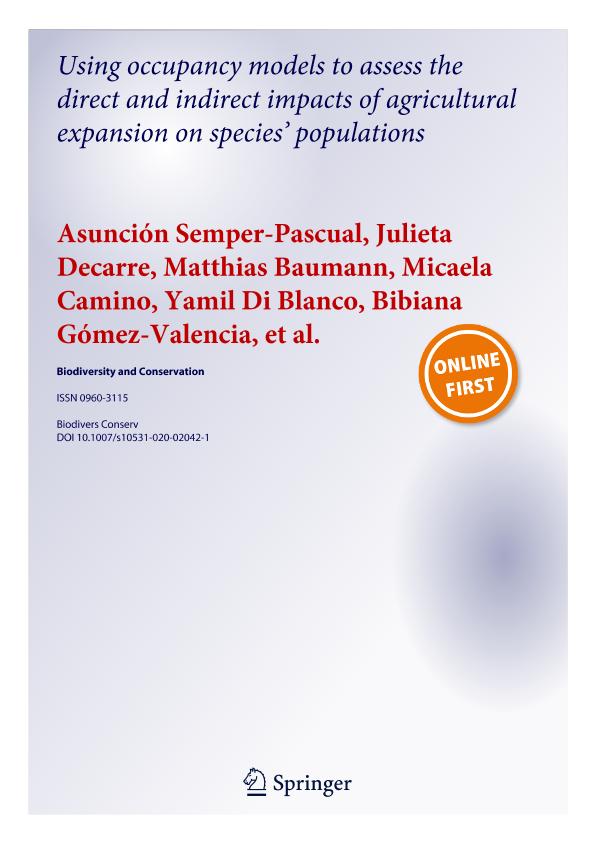Mostrar el registro sencillo del ítem
dc.contributor.author
Semper Pascual, Asunción
dc.contributor.author
Decarre, Julieta

dc.contributor.author
Baumann, Matthias

dc.contributor.author
Camino, Micaela

dc.contributor.author
Di Blanco, Yamil Edgardo

dc.contributor.author
Gomez Valencia, Bibiana

dc.contributor.author
Kuemmerle, Tobias

dc.date.available
2021-10-01T17:22:27Z
dc.date.issued
2020-08
dc.identifier.citation
Semper Pascual, Asunción; Decarre, Julieta; Baumann, Matthias; Camino, Micaela; Di Blanco, Yamil Edgardo; et al.; Using occupancy models to assess the direct and indirect impacts of agricultural expansion on species’ populations; Springer; Biodiversity and Conservation; 29; 13; 8-2020; 3669-3688
dc.identifier.issn
0960-3115
dc.identifier.uri
http://hdl.handle.net/11336/142265
dc.description.abstract
Land-use change is a global threat to biodiversity, but how land-use change affects species beyond the direct effect of habitat loss remains poorly understood. We developed an approach to isolate and map the direct and indirect effects of agricultural expansion on species of conservation concern, using the threatened giant anteater (Myrmecophaga tridactyla) in the Gran Chaco as an example. We reconstructed anteater occupancy change between 1985 and 2015 by fitting single-season occupancy models with contemporary camera-trap data and backcasting the models to 1985 and 2000 land-cover/use maps. Based on this, we compared the area of forest loss (direct effect of agricultural expansion) with the area where forests remained but occupancy still declined (indirect effect of agricultural expansion). Anteater occupancy decreased substantially since 1985, particularly after 2000 when agriculture expanded rapidly. Between 1985 and 2015, ~ 64,000 km2 of forest disappeared, yet occupancy declined across a larger area (~ 102,000 km2), extending far into seemingly untransformed habitat. This suggests that widespread sink habitat has emerged due to agricultural land-use change, and that species may lose their habitat through direct and indirect effects of agricultural expansion, highlighting the urgent need for broad-scale conservation planning in the Chaco. Appropriate management responses could proactively protect more habitat where populations are stable, and restore habitat or address causes of mortality in areas where declines occur. Our work also highlights how occupancy modelling combined with remote sensing can help to detect the direct and indirect effects of agricultural expansion, providing guidance for spatially targeting conservation strategies to halt extinctions.
dc.format
application/pdf
dc.language.iso
eng
dc.publisher
Springer

dc.rights
info:eu-repo/semantics/openAccess
dc.rights.uri
https://creativecommons.org/licenses/by/2.5/ar/
dc.subject
DEFORESTATION
dc.subject
GIANT ANTEATER
dc.subject
GRAN CHACO
dc.subject
LAND-USE CHANGE
dc.subject
TROPICAL DRY FORESTS AND SAVANNAS
dc.subject.classification
Conservación de la Biodiversidad

dc.subject.classification
Ciencias Biológicas

dc.subject.classification
CIENCIAS NATURALES Y EXACTAS

dc.title
Using occupancy models to assess the direct and indirect impacts of agricultural expansion on species’ populations
dc.type
info:eu-repo/semantics/article
dc.type
info:ar-repo/semantics/artículo
dc.type
info:eu-repo/semantics/publishedVersion
dc.date.updated
2021-09-07T19:57:40Z
dc.journal.volume
29
dc.journal.number
13
dc.journal.pagination
3669-3688
dc.journal.pais
Reino Unido

dc.journal.ciudad
Londres
dc.description.fil
Fil: Semper Pascual, Asunción. Humboldt-Universität zu Berlin; Alemania
dc.description.fil
Fil: Decarre, Julieta. Instituto Nacional de Tecnología Agropecuaria. Centro de Investigación de Recursos Naturales. Instituto de Recursos Biológicos; Argentina. Consejo Nacional de Investigaciones Científicas y Técnicas; Argentina
dc.description.fil
Fil: Baumann, Matthias. Humboldt-Universität zu Berlin; Alemania
dc.description.fil
Fil: Camino, Micaela. Consejo Nacional de Investigaciones Científicas y Técnicas. Centro Científico Tecnológico Conicet - Nordeste. Centro de Ecología Aplicada del Litoral. Universidad Nacional del Nordeste. Centro de Ecología Aplicada del Litoral; Argentina
dc.description.fil
Fil: Di Blanco, Yamil Edgardo. Consejo Nacional de Investigaciones Científicas y Técnicas. Centro Científico Tecnológico Conicet - Nordeste. Instituto de Biología Subtropical. Instituto de Biología Subtropical - Nodo Puerto Iguazú | Universidad Nacional de Misiones. Instituto de Biología Subtropical. Instituto de Biología Subtropical - Nodo Puerto Iguazú; Argentina
dc.description.fil
Fil: Gomez Valencia, Bibiana. Universidad de Buenos Aires. Facultad de Ciencias Exactas y Naturales; Argentina
dc.description.fil
Fil: Kuemmerle, Tobias. Humboldt-Universität zu Berlin; Alemania
dc.journal.title
Biodiversity and Conservation

dc.relation.alternativeid
info:eu-repo/semantics/altIdentifier/doi/http://dx.doi.org/10.1007/s10531-020-02042-1
dc.relation.alternativeid
info:eu-repo/semantics/altIdentifier/url/https://link.springer.com/article/10.1007%2Fs10531-020-02042-1
Archivos asociados
